On July 25, 2026, Pope Leo XIV celebrated the 400th Anniversary of the birth of Saint Andrew Phu Yei. Leo addressed a gathering of Vietnamese catechists, or teachers of doctrine. Andrew was born in 1625 in Vietnam and converted by Jesuit missionaries to the Catholic faith, eventually becoming a catechist. At the tender age of 19, he was martyred for his faith.
In his final words at his place of execution, he spoke the name of Jesus. For this act of devotion to Jesus, Saint John Paul II beatified Andrew in the year 2000. In Catholic teaching, saints are holy humans beings in heaven who intercede with God for believers. The believer prays to the saint, and the saint, by virtue of special access to God, prays to God on behalf of the believer.
It is tragic that Roman Catholics feel the need for the intercession of saints. They must think that they are not good enough to approach God directly. They are on earth, and the saints are in the physical presence of God. The saints have lived such virtuous lives that surely God pays more attention to them than to everyday common sinners who have yet to attain sufficient goodness to encounter God alone. This practice is, in essence, a rejection of the idea of a loving God who sees every sparrow fall.
In his remarks to the Vietnamese catechists, Leo invoked another saint for help in invoking the name of Jesus as did Saint Andrew. The Patron of Catechists is Saint Charles Borromeo, a sixteenth-century Cardinal important to the Catholic Reformation, otherwise known as the Counter Reformation, a movement centered on the Council of Trent, which took place from 1545 to 1563.
The Council of Trent and the entire Counter Reformation focused on combating the abuses and excesses of the Church as well as on re-establishing Roman dogma. At this council, Protestantism was condemned, the Jesuit order founded, and spiritual renewal emphasized. The Church also promoted the Baroque style of art to create a more impressive and visual worship experience for the faithful.
This new style was meant to be emotional, dramatic, and mysterious. Art became an important means of teaching the people through exquisite renderings of biblical scenes, lives of the saints, and sacred concepts. The appearance of Roman churches–the cavernous spaces, the vestments of the priests, the complex ritual, the Mass, the sacred objects of silver and gold and precious stones–evokes power and authority. Truth is, in a sense, transubstantiated into physical reality.
Unfortunately, the claims of Catholicism are man-made, the result of Tradition, and not God’s truth. God spoke truth through His Word and through His only begotten Son, sources that the Church, in effect, rejects.
Observers might note that an appeal to Saint Borromeo by Leo is indirectly an appeal to the Counter Reformation and its condemnation of Protestantism. When the pontiff appeals to world peace and ecumenism, this fact is important to remember. The papacy condemns the very churches it seeks to unify into one grand abomination of deception.
The meeting with the Vietnamese catechists, sweet though it seemed in spirit, demonstrates the Catholic diminution of Jesus Christ. When the pope needs to appeal to a higher-ranked saint to assist a lower-ranked saint, in order to gain something from Christ, people should recognize the sophistry of Romanism. Jesus calls to his people in Catholicism, “Come out of her, my people!”

